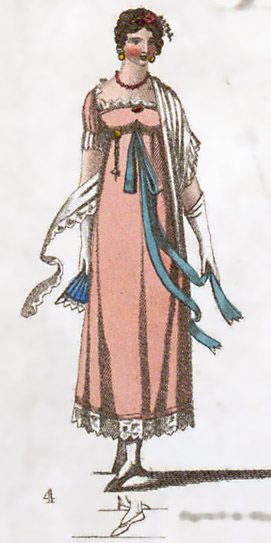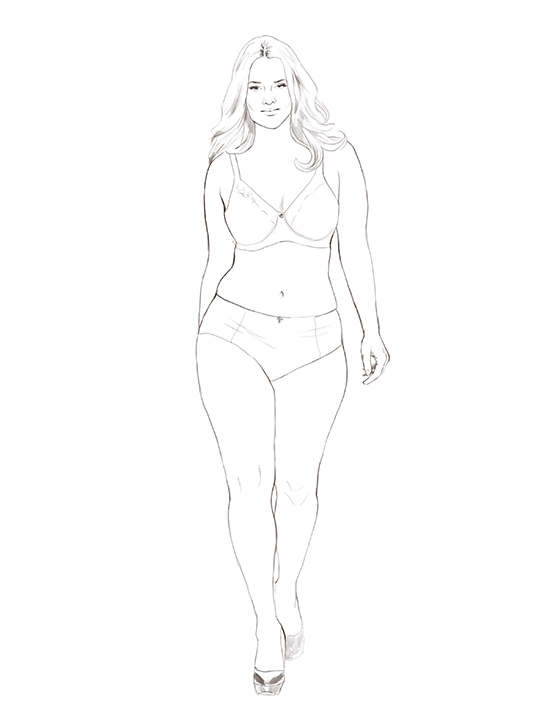Fashion illustration has been around for over 200 years, and the illustrative styles have evolved quite a bit over this time due to changes in trends and new technological advances in the field.
Read along and explore fashion illustration history!

Fashion illustration from 1811 via Wikimedia Commons
Fashion and illustration during the 17th and 18th centuries
During the 1800s, illustrations featured women with realistic proportions, clothed in big gowns or depicted in an empire silhouette, which meant a fitted bodice under the bust and a loose dress from there downward. Over time, fashion designs and trends evolved and so did the styles used to represent them on the page or canvas.

Gibson Girl Illustrations 1907 by Charles Dana Gibson via Toronto Public Library
A decade later, we come across the emergence of the “Gibson Girl.” This was the name given to the illustrative personification of what the “ideal” feminine beauty should look like. As you can see, societal standards of beauty where already quite rooted in the field early on and influenced the images created during that time. This was also when one of the most drastic and dramatic silhouette changes emerged: the wasp waist. This new and extremely exaggerated standard of beauty presented an array of serious health problems and risks to women who adopted this corseted style.

Polaire, French actress in wasp waist via Wikimedia Commons
Contemporary sketching styles
Fast forward to the 90s and we find fashion houses sending skinnier and skinnier models down the runway, and the likes of Calvin Klein establishing the “waif” look as a trend through their ubiquitous campaigns, building up the problematic image of fashion that we know today.
Naturally, these elements trickled down into fashion illustration very quickly given how connected and codependent these two fields are. Models’ bodies continued getting smaller and smaller, while illustrated figures followed suit, getting more narrow and taller. This contributed to what I would call the deconstruction of real bodies in fashion illustration, into depictions that are an entity all on their own and are not supposed to represent what real women look like, but do influence beauty standards and create unrealistic expectations.

Fashion illustrations by Antonella Avogadro
This brings us to modern day fashion sketching. Most designers sketch their designs using the 9- or 10-head figure method explained in this post. The style in which each designer illustrates their designs can be very personal and unique. Usually some of them keep the details to a minimum, even omitting the mouth and nose, the whole face and sometimes even the hair. This is because a designer wants to draw as fast as possible before losing the design idea and the ephemeral image vanishes. Other variables that can reflect the designer’s sketching style are the body shapes they are depicting. Some designers illustrate thin and curvy limbs while others, choose to represent arms and legs with very straight lines, for example.
Realism in fashion sketching
Unfortunately, there is a very deeply rooted body misrepresentation issue in the world of fashion, which you can see has been developing for years. There are more and more designers that are opting to illustrate fashion figures that come closer to more realistic proportions, and there are a few online movements that encourage anyone, from designers, to seamstresses and anyone else interested in illustrating fashion on different body types, to maintain more realistic proportions.
One of the drawbacks of the stylized figure in fashion illustration is that designers draw a design on a very slender and completely unrealistic body type and, sometimes the design doesn’t transfer the same way onto a real body. Sometimes, certain innovative shapes or silhouettes get lost in the process of creating a real garment because, just as the drawn figure is distorted, so is the garment sketch.

There is a lot of room in the fashion world to expand the playing field and set the rules aside to make your own. The stylized 10-head figure method of drawing fashion is taught in fashion schools as the method to draw fashion. Look at fashion design and sketching books or even an online search and this is the method taught and applied for sketching designs.
What if we challenged the notion of this being the one and only way to illustrate fashion? What if you traced your body type, or any other body type you want to design for and illustrate your ideas on that? I’ve shown some examples below and would recommend Tracing Real Body Models for other templates.
 Download this free fashion illustration template here.
Download this free fashion illustration template here.

The beauty of design is that it is not and exact science, you can get fantastic results by breaking the rules or even rewriting them. Sometimes, that’s exactly what you need to do so that your work doesn’t look exactly like everything else that has already been created. All you need is to dare to break the mold. What’s your take on fashion illustration?


Share tips, start a discussion or ask one of our experts or other students a question.
No Responses to “The History of Unrealistic Proportions in Fashion Illustration”